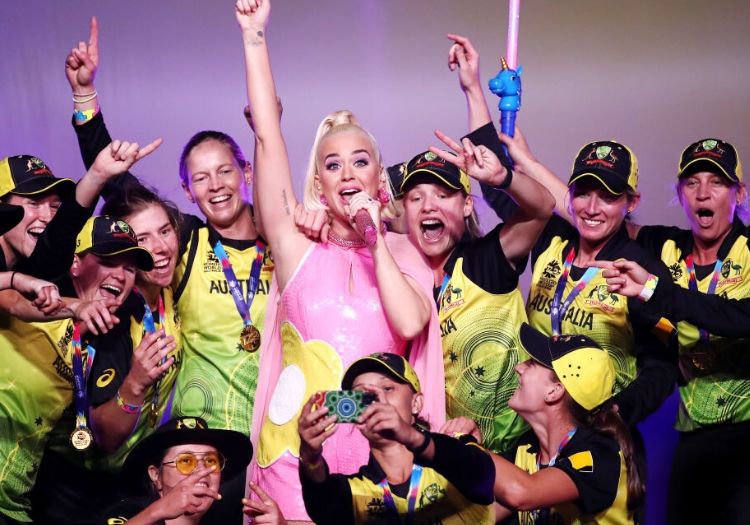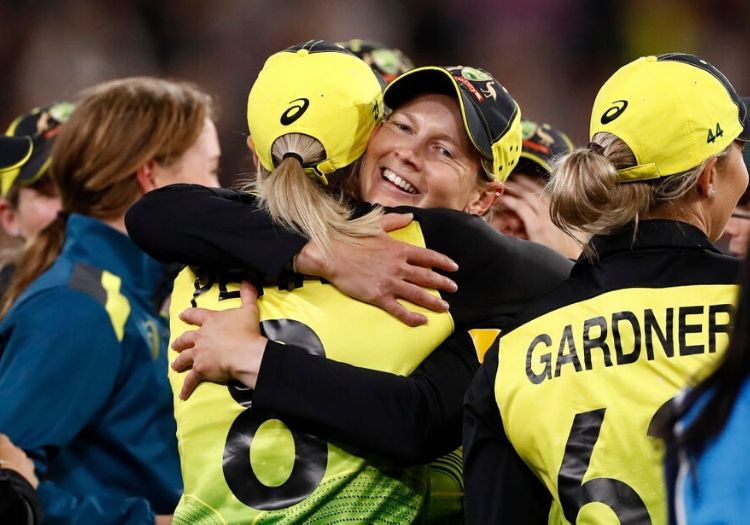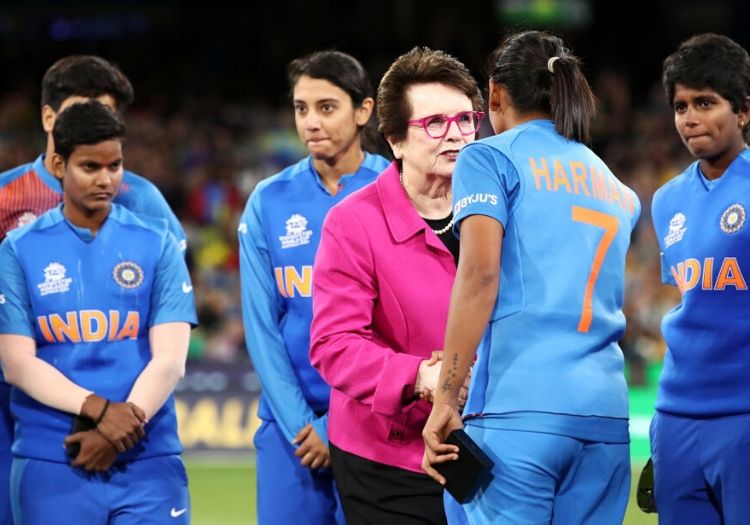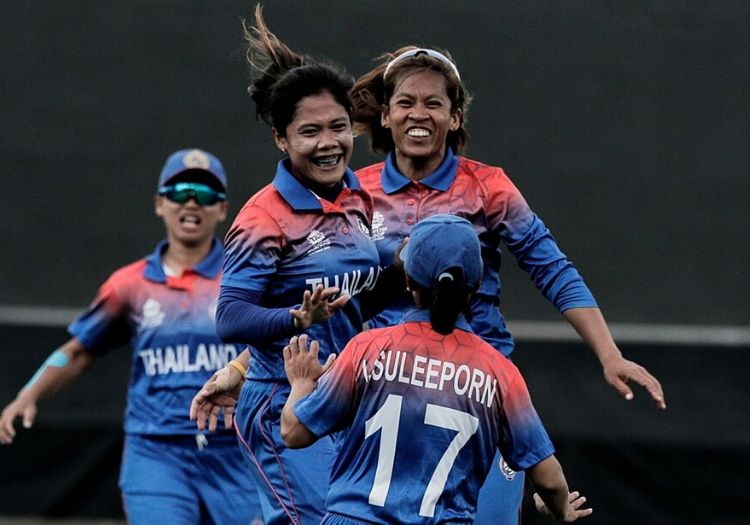NICK FRIEND: Women's cricket has never seen anything like this: a tournament that began with a shock and ended with fireworks. Even with Ellyse hamstrung, Katy flew the flag for the Perry name. A victory and an advert for ambition

Things will never be the same again. How can they be? That’s the bar. It has been set now – not for record crowds, but for ambition.
This was different, of course. It was a World Cup final. But make no mistake, the landscape has shifted.
When the commercial viability and the marketability of women’s cricket is next questioned, just point to when 86,174 men, women, boys and girls packed into one of the world’s most iconic sporting venues – an arena where, prior to Sunday, the previous record crowd for a women’s game was just 7,028. Eleven years ago, 2,300 people watched the 50-over World Cup final at North Sydney Oval.
What happens next is vitally important, but it is a discussion for another day – for a time after the dust has settled on the most remarkable occasion that the women’s game has ever seen. This cannot be a flash in the pan, but it surely won’t be.
It was good enough for Billie Jean King and it was good enough for Katy Perry, whose own performance hit just the right level of joyous empowerment on International Women’s Day.
The women’s game has made several statements in recent years and Cricket Australia has been at the forefront of many of them, but none have been as powerful as this.
“If I was to tell my 10-year-old self to keep chasing her dreams, I'm not sure if she'd believe me, but God I'm glad she did,” Delissa Kimmince reflected afterwards, her words having to squeeze through an unshakeable smile.
“I never thought I'd be playing in front of a crowd like this,” admitted Ashleigh Gardner.
“This day is incredible, we couldn’t have dreamed of this,” said Meg Lanning.
“I never thought we'd get an opportunity to do something as cool as we did today and play in front of almost 90,000 people at the MCG in a home World Cup final,” added Alyssa Healy, whose name will forever be attached to this moment in history.
“It's a dream come true. I enjoyed every single minute. I don't think you saw me without a smile on my face that whole time because we just went out there and enjoyed the moment.
“We enjoyed what we were able to create. Cricket has done some amazing things in this country for female athletes, and tonight was really just a celebration of that.”
It is easy to take greatness for granted. It is why there was such excitement when India turned the tables on the hosts in the very first game of the tournament in front of what was – for two weeks only – a record crowd in Australia for a women’s cricket match. It created jeopardy and doubt around a team that deals only in certainty.
Lanning’s side are unmatched and exist as a representation of their domestic structure – they deserve to be mentioned alongside the All Blacks for their pure levels of world domination and the way in which they have transcended their own game; this latest triumph was achieved without the greatest female cricketer of all time and under the most suffocating pressure. Only, they never allowed themselves to be overawed by it nor affected by Ellyse Perry’s absence; Healy, rather, played like a woman possessed by freedom and self-belief, not tightened by the knowledge of expectation.

Meg Lanning and Ellyse Perry embrace after Australia's win
It would be easy to focus solely on the world champions here. But there is a wider theme at play, which begins with Australia and stretches through the story of this tournament: investment.
And that is how this year’s T20 World Cup should be remembered: two world-class youngsters now top the ICC batting and bowling rankings, a previously unknown cricketing nation announced itself on the world stage and the MCG was, indeed, packed almost to the rafters.
The major negative – the farcical rain provisions around the semi-finals – you sense, will be corrected before it is allowed to manifest itself once again. See the disappearance of boundary countbacks for prior precedent. Sometimes, it takes a farce to recognise a farce.
Anyway, Lanning’s Australia and Sornnarin Tippoch’s Thailand are two chapters from the same tale – of investment and sporting ambition. They are at different stages of their journeys, granted, but the direction of travel is the same. The same is true of Pakistan, much improved this time around, and of South Africa as well.
But in truth, it was fitting that Australia should come out on top at the end of this landmark fortnight – a vastly superior side who, when at their best, remain supremely untouchable. Not a single team went unbeaten, while only one – an ever-improving Bangladesh – lost every game.
The strength in depth was – in some cases – a visible improvement on anything that had come before. Pakistan left out Sana Mir, but still had enough to impress – a nation on the rise thanks to an increased focus on the women’s game. It will be a slow process, but this was encouraging.
Bismah Maroof would ultimately be forced out of the tournament early through injury. Yet, the 28-year-old had already shown herself to be a fine leader. Her country’s win over West Indies was among the performances of the competition. To look back on it as an upset would be disingenuous.
First and foremost, Stafanie Taylor’s squad simply never got going. Deandra Dottin looked a shadow of her fully-fit self, Hayley Matthews never found her best form and the reliance on Taylor felt greater than ever before. For the first time since 2009, they failed to get beyond the group stage. You just hope this is not the beginning of a sharp decline.
Pakistan dominated their encounter and several opposition players commented on their progression. In Diana Baig, they possess one of the event’s standout seamers, while Javeria Khan has become a consistent performer at the top of the order.
These are early days for their development as a team, but a seventh win in T20 World Cup history was a sign of tangible, marked progress. And against former world champions as well, it was a mightily significant result. On a slow surface, they did not rely on boundaries, but rather possessed a fine sense of game management – an ability to rotate the strike at will that, quite frankly, has not always been evident.
Pakistan finished fourth in Group B; there are more compelling stories to recount from this tournament, but what was noticeable in their campaign was evident elsewhere. That keyword once again: investment.
More than anything else, that is what these 17 days have boiled down to. It is why Australia have become such a frighteningly consistent juggernaut – driving the women’s game forward both on and off the field, but it is also why Pakistan are improving, why India came closer than ever before to T20 glory and why Thailand arrived on the world stage.

Billie Jean King was on hand to commiserate with India following the final
Australia’s squad, don’t forget, are in line for a significant payday, given the national governing body’s promise to match the women’s prize money with the men’s equivalent winnings. They don’t play for the money, of course, but it is just another reminder of Australian cricket’s investment in its women. It follows a standalone Big Bash – now five years old and established as the premier competition of its kind, an MOU that sees male and female professional players paid the same base hourly rate and a landmark parental leave policy. Women make up 30 per cent of all cricketers in the country.
And then, we move to the story of Tippoch’s Thai team. Their voyage is at its beginning; the entire tale is little over 10 years old. For the next few days, it will sink beneath the radar as the world reacts to Katy Perry, Lanning and Healy. And that is not a problem in the short term.
What is important, though, is that the Thailand precedent is built upon and used, however cynically, to open up the sport further afield. International cricket’s major global growth platform is the women’s game; it does not hold the same establishment history as the men’s game and it has the potential to expand exponentially in the next decade.
Talk of Thailand, for the most part, was restricted to the squad’s boundless enthusiasm and joyful demeanour. Understandably, there was an element of novelty to the very notion of a country from south east Asia dining at the top table of a global ICC event. They were there on merit too, having seen off Ireland, Scotland and the Netherlands at a qualifying event late in 2019. And they will only improve. It should shame the ICC that stories like these are being forcibly diminished by ringfenced, 10-team World Cups.
Beyond the smiles and the dancing, however, was a group of players with the talent to move forward and become far more than just an intriguing long read and a taxing piece of trivia. Unlike many sides that develop out of non-traditional cricketing nations, they fielded superbly and more than looked the part when hunting in the ring. More typically, perhaps, they were raw with the bat – seemingly finding it difficult to score when there was little pace on the ball, but then also struggling against the quicker bowlers.
At least, that was the case until they faced Pakistan in their final game, racking up 150 for 3 at the Sydney Showground Stadium – the highest score made by any team at the venue. Nattakan Chantam and Nattaya Boochatham put together a stand of 93 in 13.3 overs for the first wicket. Given the absence of Maroof, Thailand would have fancied themselves to win that game had poor weather not intervened.
In truth, that was one of the great disappointments of the competition – a pleasure to watch, but also tinged with sadness. Thailand dominating a full member was remarkable; even their fielding display against West Indies was a statement of intent. But just imagine what a Thai win – on their global tournament debut – might have done. Their appearance has already raised awareness of what might be possible for others, but a victory would have opened the floodgates. They came closer than many might have believed they could.

Thailand made their ICC global tournament debut
They were a terrific advert for the associate universe as much as the women’s game; the ICC could do far worse than to begin their post-World Cup reflections with plans for more cricket for emerging nations, especially if talks of a Champions Cup are to come to fruition, which would mean increasing the time between T20 World Cups and, as a result, providing less incentive for countries to invest.
There is nothing to say that others should not follow Thailand. There is even less to say that women’s cricket should have to adhere to any status quo. The United States are four-time FIFA Women’s World Cup winners; not since 1930 have their men made it past the quarter-finals. In other sports, different countries dominate in men’s and women’s events. Why should cricket be any different?
There is serious potential in nations where hockey is a major women’s sport – Argentina, for one, have a burgeoning women’s system and have forged a competitive rivalry with Brazil, who have blazed a trail of their own.
A month before the tournament got underway, they handed central contracts to their women’s team; their men do not have them, but this crop of female players has been earmarked by Matt Featherstone, the federation’s president, as a group with a genuine chance of doing something remarkable.
He told The Cricketer that Thailand existed as “the perfect example” of what his side could look to emulate.
“Soon, we are going to be knocking on the door of the top 20 countries, asking to play games,” Featherstone explained.
“This has been done on merit. The people that are taking this forward are the women’s team. It’s a definite merit-based decision. The level is just going to get better and better every year.”
He is speaking for the wider world. Quite simply, there is no reason why not. Thailand have shown the way. But, so too have the improvements of other nations.
South Africa had only ever won eight games in six previous T20 World Cups, before arriving for a tour that began in New Zealand and ended in desperate, rain-soaked disappointment at the SCG. They had never even played a T20I in Australia until they faced England at the WACA.
For Dane van Niekerk’s side, it was a case of a plan finally coming together. There have been few stronger spines in the women’s game than one including Lizelle Lee, Van Niekerk herself, Marizanne Kapp and Shabnim Ismail. With Chloe Tryon, Laura Wolvaardt and Sune Luus all growing into their roles, there was a feeling that this might finally be the Proteas’ time. They came so close to becoming the first ever South African side – male or female – to reach a World Cup final.
With the next tournament on home soil, they will hope to be similarly well placed in two years’ time. Their win against England, once the Sydney rain ruined semi-final day, ultimately – though indirectly – knocked Lisa Keightley’s side out. With 40 new full-time domestic contracts set to be introduced by the ECB at the heart of a major domestic overhaul, we return to the buzzword once more: investment.
Australia has shown the world what is possible – as a host nation and as a phenomenal cricket team. Things will never be the same again.